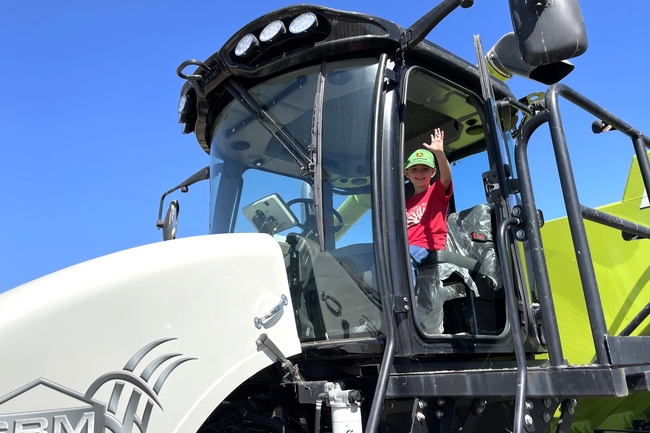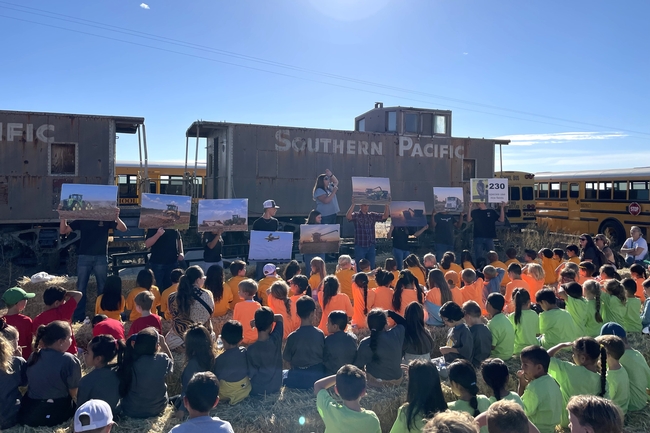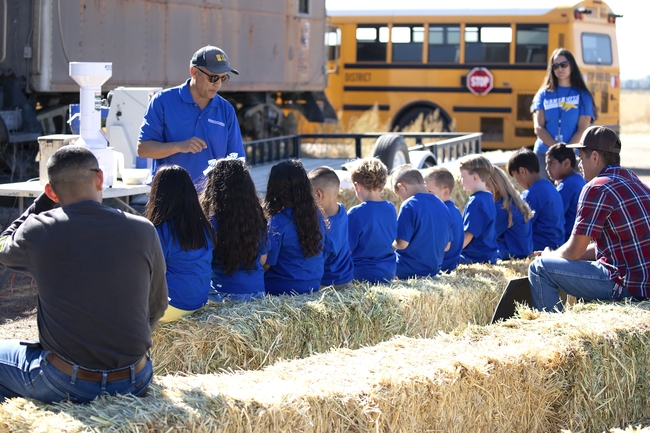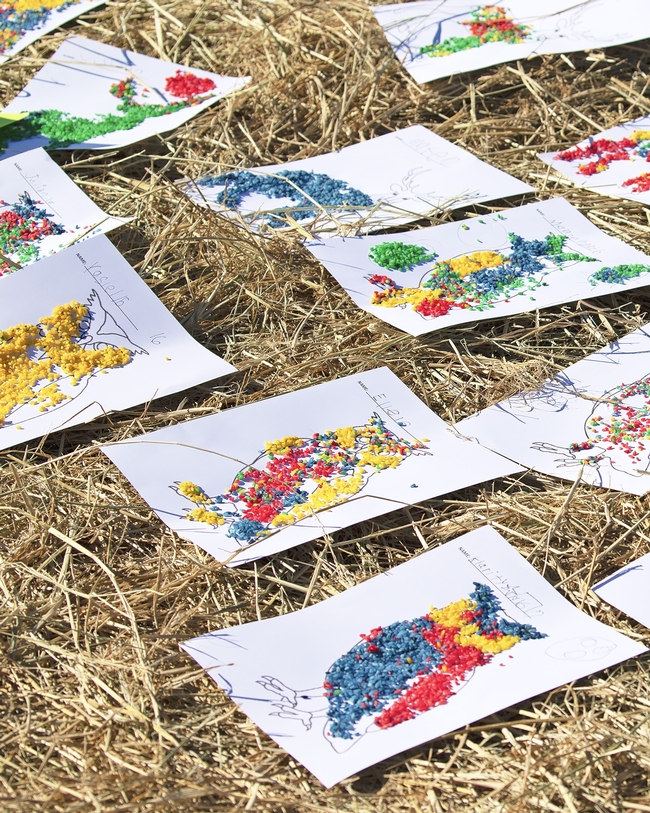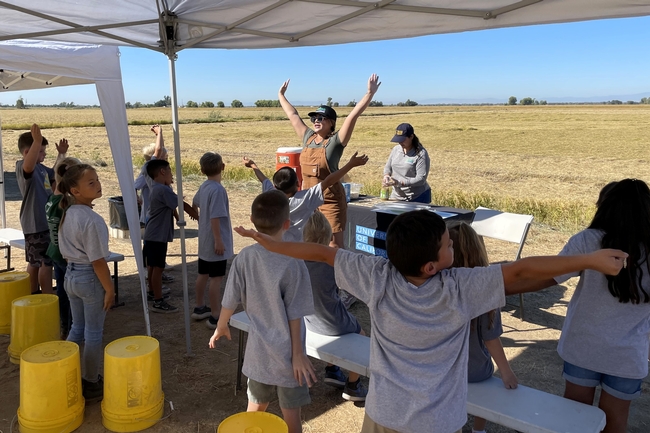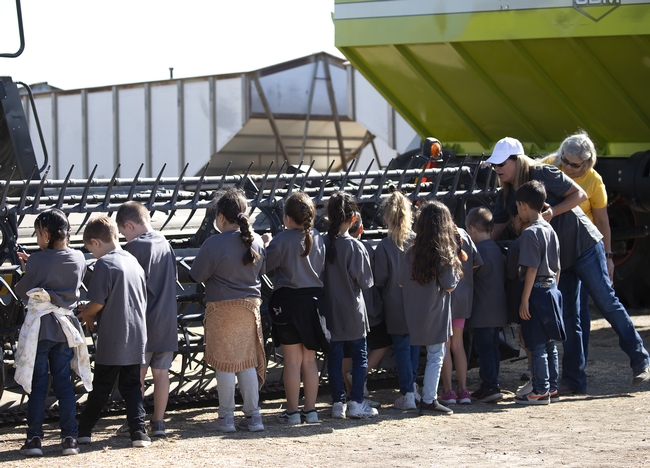Posts Tagged: extension
Extreme weather accelerates nitrate pollution in groundwater
Extreme weather spurred by climate change, including droughts and heavy rains, may increase the risk of nitrates from fertilizers ending up in groundwater, according to a recent study from researchers at the University of California, Davis. The study found heavy rains after a drought caused nitrates to seep 33 feet under farm fields in as little as 10 days. The study was published in Water Resources Research.
“The conventional wisdom was that it could take several weeks to years for nitrates to move from the crop root zones to reach groundwater,” said corresponding author Isaya Kisekka, a professor in the Departments of Land, Air and Water Resources and Biological and Agricultural Engineering. “We found these extreme events, such as California's atmospheric rivers, are going to move nitrate more quickly.”
In this study, different methods were used to measure how much nitrate, a component of nitrogen fertilizer, was seeping down through the soil in a tomato and cucumber crop near Esparto, California. Scientists conducted their research from 2021 until 2023 when California was experiencing periods of drought followed by atmospheric rivers. They measured nitrate during both the growing seasons and the rainy seasons.
Drought can leave more nitrogen in soil
Previous studies have shown about 40% of nitrogen fertilizer used for vegetables isn't absorbed by the plants but remains in the soil. During droughts, crops don't use nitrogen efficiently, leading to excess nitrogen in the soil. This study found that if a drought is then followed by heavy rainfall, that sudden burst of water causes nitrate to seep in groundwater more quickly. The nitrate concentration in the shallow groundwater exceeded the U.S. Environmental Protection Agency maximum contaminant level of 10 milligrams per liter for drinking water.
“In California, we often say we swing between droughts and floods,” said Kisekka. “These extreme events that come with climate change are going to make the risk of these chemicals ending up in our drinking water much more severe.”
Groundwater is the primary source of drinking water for most of California's Central Valley. In some regions, such as the Tulare Lake Basin, nearly one-third of drinking and irrigation wells exceed the EPA's safe nitrate level. High nitrate levels in drinking water can increase health risks, especially for young children. It may also increase the risk of colorectal cancer.
Need for real-time soil nitrate monitoring
Central Valley farmers are required to report to the Regional Water Board how much nitrogen they applied to their field and how much was removed as part of the crop's yield. The study compared different ways of monitoring when nitrate from fertilizers seep into groundwater. Kisekka said the results highlight the need for affordable, real-time soil nitrate monitoring tools to help farmers manage fertilizer use efficiently.
By using conservation practices that limit leftover nitrates in the crop's root zone after harvest, farmers can help reduce nitrate contamination in groundwater.
This study's data will also help improve a model called SWAT, which is used to track nitrate seepage into groundwater across California's Central Valley. This effort is part of the Central Valley Water Board's program to regulate irrigated farmlands.
Other UC Davis authors include Iael Raij Hoffman, Thomas Harter and Helen Dahlke.
The study was supported by the USDA Natural Resource Conservation Service through its Conservation Effects Assessment Project. The national project is designed to assess the effectiveness of conservation practices across different watersheds. The study also had support from the USDA National Institute of Food and Agriculture.
Butte County first graders enjoy ‘ricetastic’ day at local farm
UC Cooperative Extension advisors, educators join growers in showcasing rice production
When Tracy Schohr volunteered in her son's pre-K class a couple years ago, she was stunned to find out that only two of the 20 children had ever been around a tractor. And this was in the rural Butte County community of Gridley, in the heart of California's rice-growing region.
Seeking to introduce more young children to agriculture, Schohr – the University of California Cooperative Extension livestock and natural resources advisor for the area – and her friend Lisa Donati created an event to showcase rice farming.
After the debut of “Ricetastic Day” last year with about 140 students from Gridley in attendance, this year's event on Sept. 19 attracted more than 240 schoolchildren – this time from across south Butte County.
First graders from McKinley Primary School in Gridley, Manzanita Elementary School, Biggs Elementary School and Richvale Elementary School – along with their teachers and many family members – enjoyed hands-on experiences at Schohr's rice and cattle ranch.
“There's a dwindling population that produces the food that we eat across America, so how can we have more people know, appreciate and love agriculture if we don't give them that opportunity?” said Schohr. “That's what this day is really about – to teach them about rice, to teach them about their community, how healthy rice can be, and how the farming and ranching can also create habitat for wildlife. It's all-encompassing.”
Event stations share different aspects of rice
Schohr, who grew up on the family ranch in Gridley, remembers coming with her McKinley schoolmates for a visit. But those field trips had comprised only lunch and a quick “drive-through” tour of the historic farming operation.
For Ricetastic Day, however, Schohr organized – with generous help from local growers and community partners – a more comprehensive half-day of activities. After her brother, Ryan Schohr, welcomed the participants to the family farm, the students formed groups that were led by Gridley FFA youth on a rotation through a variety of stations.
At the milling station, Luis Espino, UCCE rice farming systems advisor, demonstrated how his mini mill machines remove the husks from rough rice to make brown rice, and then polish away the bran layer to make white rice. He had the children see and feel the difference as the rice moved through processing.
“I didn't even know brown rice existed!” exclaimed Elsie, a first grader at McKinley.
A native of Peru, Espino came to study agriculture through his lifelong fascination with biology and living things – and he said events like Ricetastic Day can inspire a similar passion in young people.
“It might spark their curiosity so that they might go into these areas of work in the future or have a career in agriculture, when they see that people do this for a living,” Espino said.
Ray Stogsdill, another McKinley school alumnus, returned to Gridley after college to pursue just such a career. A staff research associate in the lab of UC Davis professor Bruce Linquist, Stogsdill manages on-farm rice variety testing across the region. He volunteered to help Schohr with Ricetastic Day by talking about some of the heavy equipment and providing his perspective for the kids.
“They drive by the fields and they don't know what's out there,” he said. “This gives them a chance to know what they're driving by, so they can say, ‘We have rice here and this is how it works; this is how it grows.' It gives them an idea of what's going on around them.”
Where rice fits within a healthy diet was the focus for the CalFresh Healthy Living, UC Cooperative Extension team, comprising nutrition educators Sunshine Hawjj, Joanna Aguilar and Kenia Estrada, as well as community nutrition, health and food security advisor Veronica VanCleave-Hunt. They talked about how rice – like other grains in that vital food group – gives people energy, and then taught the students an energetic “ricetastic” movement activity.
“Because our program is part of UC Agriculture and Natural Resources, it's important to make the connection between where our food comes from and how it gets on our plate – especially with young kids, so that we can promote value for our local agriculture and our food systems,” VanCleave-Hunt explained.
Activities spark further conversations, learning about agriculture
With rice harvest late due to late planting in the spring, Eric Waterbury of Waterbury Farms was able to take some time to attend the event. Although his family has been growing rice for three generations, he said he appreciates opportunities for the broader community to see all aspects of his work – from the equipment to the processing.
“If the kids walk away from this with one thing, I hope it's that they realize every time they have a meal, somebody was out there working hard to provide that meal,” he said. “It wasn't just the person at the grocery store that provided it for them.”
Schohr added that Ricetastic Day was only possible through the support of the community. Butte County Farm Bureau and Natural Resources Conservation Service staff helped kids make art with colorful dyed rice; neighboring farmer Tinker Storm described how the harvester and “bankout” wagon work; and rice farmers Shelley Beck and Sue Orme read aloud “Daddy's Got Dirt: A California Rice Story,” a children's book written by a local rice grower.
With rice at the center of physical activities, arts and crafts, and science lessons for the day, the students learned a lot to take home.
“It's nice that the kids got these hands-on learning experiences,” said Ryan Schohr, “so they can go home tonight and, at the dinner table, talk about it with their parents or brothers and sisters, over dinner or over homework – and share what they learned here on the farm and about their community.”
Rebecca Christy, a first- and second-grade teacher at Biggs Elementary, said she is excited to return to the classroom and hear from her students about all that they learned during the day.
“Every morning right now I'm seeing the big trucks going by our school, and so I'll be able to point that out to them, ‘Where are they going? What are they doing?'” she said. “I can't wait to get back to school and let them tell me about all of this.”
One of her students, Ximena, was finishing her brownbag lunch as the group watched one of the Schohr Ranch harvesters rumble over the field. Despite enjoying a rice cake and a rice cracker earlier, she said her meal was missing one thing.
“Where is my rice, Miss Christy?” she said. “I want rice!”
Lawn-pocalypse! Surviving Drought
Ah, summer! The season of sunburns, pool parties, and… lawn droughts. If your once lush, green carpet now looks like a crunchy brown doormat, you're not alone. Let's dive into why your yard is staging a dramatic death scene and what you can do to...

Bermuda grass and weeds overtaking drought stressed turf grass.
Postharvest Center: New research focus and outreach
Still providing the world with top-notch information
UC Davis has been a leading source of information for people handling, packaging and transporting crops since the beginnings of the Postharvest Research and Extension Center in 1979. Now, the center is strengthening its focus on the needs of industry, offering fresh courses, weaving strategic partnerships and expanding into digital media, all while building up its research capacity to better serve the needs of the produce industry.
“We're asking people in the industry, ‘How can we support you? How can we better listen to you?' We want people to know we're not disconnected know-it-alls,” said new center co-director Bárbara Blanco-Ulate, an associate professor in the UC Davis Department of Plant Sciences. “We're getting more faculty involvement, people with expertise in related fields such as quality engineering and safety, as well as bringing in emeriti faculty and people from around California. We're forming partnerships with organizations around the world, and we've opened up to people from other institutions around the country.”
“The larger the network, the more things we can do,” added fellow co-director Irwin R. Donis-Gonzalez, an associate professor of UC Cooperative Extension in the Department of Biological and Agricultural Engineering.
The foundation: Expanded research
The new co-directors will beef up the center's applied science component with the hiring of a research specialist. They aim to provide new information that can be used industry-wide as companies explore new ways to handle and store fresh produce.
“We're building the capacity to respond to industry requests for research,” Blanco-Ulate said.
New courses, national reach
Their first workshop, held recently, demonstrates the center's renewed vision and commitment to broad networking: The Agricultural Water Systems Workshop addressed current concerns around water management and risks to food safety. Partners in the course included the Western Growers Association, the University of Arizona, the University of Florida and Salinas-based Taylor Fresh Foods, Inc.
Courses given over the past several years that have been recorded will be posted to the center's new, online video library and to the center's YouTube channel.
“People can watch those courses for free,” Blanco-Ulate said. In addition, new courses will be offered in-person and hybrid.
The co-directors are working with the University of California to offer continuing and professional education credits to course participants.
Online resources – many for free!
The center's website features a database with scores of free product fact sheets, which are downloaded by users around the world. The fact sheets are so highly regarded that they are considered expert evidence in legal proceedings, Blanco-Ulate said. Visitors to the website can also find links to research papers published by UC Davis faculty, including seminal works by Adel Kader, who founded the center.
Books are offered through the center's online bookstore and include titles through UC Agriculture and Natural Resources. Ten new titles are being planned, including topic-specific updates taken from previous classics.
Debunking myths: Ethylene
A new newsletter deals with a new problem: Misinformation about food and food handling that spreads through social media. One example is the use of ethylene to ripen produce such as bananas, so that they can be safely stored until ready for the consumer.
“Ethylene is safe for humans and does not leave any harmful residue on produce,” Donis-Gonzalez wrote in the center's latest newsletter. Even better news, he added: The levels of ethylene used on food are a tiny fraction of the concentrations that would be needed to create an explosion, one of the false alarms being raised in social media.
Evolving with the times
After 47 years of service, these and more updates will keep the center at the forefront of an evolving postharvest world. The top goal: Meet the needs of agriculturalists, industry and consumers.
“We are adapting to new needs, with both the resources and the workshop we're offering,” Donis-Gonzalez said.
“As a land-grant institution, we take our outreach mission seriously,” Blanco-Ulate added.
Related links
More about the UC Davis Postharvest Research and Extension Center.
This story first appeared on the UC Davis Department of Plant Sciences site.
2024-25 UC Cooperative Extension positions announced
Dear Colleagues,
It is with great pleasure that I announce that the University of California Agriculture and Natural Resources (UC ANR) is continuing to support the research and extension needs of California through placement of new University of California Cooperative Extension (UCCE) Advisor and Specialist positions. Thanks to extensive collaboration with campuses across the UC system, our UC Research and Extension Centers (RECS), UCCE County offices, and our many partners in government and the private sector, the following positions have been approved for recruitment:
UCCE Advisors:
|
Discipline/Specialty |
Counties Served |
Office Location |
|
4-H Youth Development: College and Career Readiness |
Lake and Mendocino |
To be determined (TBD) |
|
4-H Youth Development: College and Career Readiness |
Alameda and Contra Costa |
Alameda
|
|
4-H Youth Development: College and Career Readiness |
San Luis Obispo, Santa Barbara and Ventura |
TBD |
|
4-H Youth Development: Leadership and Civic Engagement |
Modoc, Lassen, Plumas and Sierra |
Lassen |
|
Agricultural Workforce Development |
San Joaquin Valley |
TBD |
|
Agronomy |
Sacramento, Solano and Yolo |
Yolo |
|
Avocado, Citrus, and Subtropical Fruits |
Riverside and San Diego |
San Diego |
|
Citrus and Pistachio |
Kern, Kings and Tulare |
Tulare |
|
Commensal Rodents & Urban Wildlife Integrated Pest Management |
Alameda, Contra Costa, San Mateo, San Francisco and Santa Clara |
Santa Clara |
|
Disaster Preparedness, Response, and Resiliency |
Monterey, San Benito and Santa Cruz |
TBD |
|
Environmental Horticulture |
Riverside and San Bernardino |
TBD |
|
Environmental Horticulture & Controlled Environment Agriculture |
Monterey, San Benito, San Mateo and Santa Cruz |
TBD |
|
Field and Vegetable Crops Integrated Pest Management |
Fresno, Kings, Madera and Tulare |
West Side REC |
|
Food Systems |
Los Angeles and Ventura |
Ventura |
|
Fruit Postharvest Handling |
Fresno, Kern, Kings, Madera and Tulare |
Lindcove REC |
|
Horticulture and Small Farms |
Nevada and Placer |
Placer |
|
Livestock and Natural Resources |
Lake and Mendocino |
Mendocino |
|
Livestock and Natural Resources |
Marin and Sonoma |
Sonoma |
|
Livestock and Natural Resources |
Shasta and Trinity |
Shasta |
|
Low Desert Weed Management |
Imperial and Riverside |
Imperial |
|
Nutrient Management & Forage Systems |
Merced, San Joaquin and Stanislaus |
Stanislaus |
|
One Health Integrated Produce Safety |
Monterey, San Benito and Santa Cruz |
TBD |
|
Orchard Systems: Almond, Apricots, Peaches, and Pistachio |
San Joaquin and Stanislaus |
Stanislaus |
|
Orchard Systems: Apples, Cherries, Olives, and Walnuts |
San Joaquin and Stanislaus |
San Joaquin |
|
Outdoor Recreation/Connected Communities |
Lassen, Plumas and Sierra |
Plumas |
|
Vegetable Crops |
Butte, Colusa, Glenn, Sutter and Yuba |
Colusa |
|
Vegetable Crop and Weed Science |
Monterey, San Benito and Santa Cruz |
Monterey |
|
Viticulture and Tree Fruit |
Sacramento, Solano and Yolo |
Sacramento |
|
Weed Science |
Marin, Napa and Sonoma |
Sonoma |
Specialists:
|
Discipline/Specialty |
Host / Location |
|
Agricultural Acarologist |
UC Riverside Dept. of Entomology / Kearney REC |
|
Agricultural Economics: Small Farms and Rural Economic Development |
UC Santa Cruz Department of Economics; Center for Agroecology |
|
Agricultural, Food and Natural Resources Computational Data Science |
UC San Diego Supercomputer Center |
|
Agricultural Waste Management and Bioenergy Production |
UC Merced Dept. of Mechanical Engineering |
|
Agricultural Policy |
UC ANR / California Dept. of Food and Agriculture |
|
Agricultural Technology Workforce Development |
UC ANR / TBD |
|
Beef Cattle Production Systems |
UC Davis Dept. of Animal Science |
|
Climate Resilient Orchard Systems |
UC Davis Dept. of Plant Sciences |
|
Climate Resilient Rural Community Development |
UC Berkeley ESPM |
|
Coastal Hydrology Agriculture and Water Resilience |
UC Santa Cruz Dept. of Earth and Planetary Sciences; Center for Agroecology |
|
Coastal Produce Safety Systems |
UC ANR / USDA ARS Salinas |
|
Field Trials and Testbeds Design and Operation |
UC ANR VINE / Kearney and Westside RECs |
|
Food Safety/Drones/Remote Sensing |
UC Santa Cruz / Monterey Bay Education, Science and Technology Center (MBEST) |
|
Groundwater Quantity and Quality |
UC Merced Dept. of Civil & Environmental Engineering / West Side REC |
|
Mental and Emotional Health in Youth Families and Communities |
UC Davis Dept. of Human Ecology |
|
Oak Woodland Management and Conservation |
UC ANR / Hopland REC |
|
Organic Production: ANR OAI Academic Director |
UC Merced Dept. of Life and Environmental Sciences |
|
Outdoor Recreation |
UC ANR / CA Governor's Office of Business and Economic Development |
|
Recycled Water Reuse and Brackish Water Desalination |
UC Davis Dept. of Land, Air and Water Resources; Biological and Agricultural Engineering |
|
Sustainable Dairy Cattle Nutrition |
UC Davis Dept. of Animal Science |
The UCCE Advisor positions will be released for recruitment in small batches over the next several months to facilitate engagement of various selection committees. The UCCE Specialists will be released to campuses for recruitment upon completion of the Memorandums of Agreement (MOAs) currently being renewed between UC ANR and the campuses/host sites.
We wish to thank the UC ANR program teams, county and REC directors, leadership from the UC campuses, the Program Council, and all of our collaborative partners who assisted with this position call, submissions and reviews. We truly could not be successful without your engagement and expertise.
Glenda Humiston
Vice President


